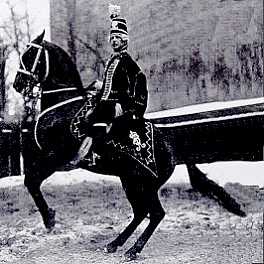What Exactly is Dressage? Or “How fancy are your pants?”
“Does Dressage Need a Makeover to Attract a Mass Audience?”

Felix Bürkner – classically correct in ‘fancy pants’. The occasion: A costume ball in the 1920’s. Image courtesy of equivox.de.
This headline appeared in social media this morning, linking to an article by a British horse magazine. Below it, a young rider in a purple dressage coat, lavender pants, horse decked out in matching colors. Frankly, I don’t remember what exactly the horse looked like, apart from the colorful accessories.
Now, thinking about that question again, all I remember in my mind is the rider’s flamboyant outfit. Reading through the ‘yeah’ and ‘nay’ comments and opinions of others, I simply can’t come up with an intelligent answer, in spite of sipping on a decaf soy latte.
But, wait a minute… Is this even the right question to ask?
“There are no right answers to wrong questions.” – Ursula K. Le Guin
Whenever there is the need for analysis, there is a need to ask the right questions and confirm the definition of the substance at stake (IT project managers will agree here).
In other words, if we want to determine whether a change needs to be made, let’s make sure we are all talking about the same thing. What exactly are we talking about? DRESSAGE, you will say.
What Exactly Is Dressage?
And where do we find the correct definition?
Logically, we would turn to the ‘rules we ride by’. The ‘rules’ are the FN Principles of Riding, which in turn are based on the pure and unadulterated classic German riding theory and source of today’s “Training Scale”, the HDV12 German Cavalry Manual, last edition of 1937. Let’s see how the HDV12 defines dressage:
“In order to be able to fulfill all requirements that military duty demands of a war-ready cavalry horse, the green horse’s body needs to be systematically developed by means of gymnasticizing, and the horse needs to be carefully educated. Both elements combined are called dressage.” (HDV12 German Cavalry Manual for Training Horse & Rider, 1937)
This makes a lot of sense. So Dressage is a means to an end, not an end itself. Horsemen, mostly in the cavalry, culminated practical knowledge over centuries, learned what works and what doesn’t when it comes to creating an able and willing equine partner, documented this and it in the form of an Army Regulation.
“…The goal of dressage is to school the horse to the optimum performance level and to make it obedient. This goal can only be achieved if the horse—while maintaining and developing its natural [mental and physical] disposition—is brought into a form and posture in which it can fully develop its potential. In such form and posture, the horse will be able to prove equal to the demands of service for a long time.” (HDV12/1937)
Aha! So the goal is to create an willing and able equine athlete, who will stay healthy and usable for a long time! In 2015 speak: ROI (Return On Investment), folks!
In the context of preparing the horse for a partnership in military service (end), dressage was the systematic schooling (means) needed to create this able military steed. Not an end in itself.
Dressage competitions, in turn, are merely benchmarking events. Here is where riders show how far they have come in their schooling of their horse, here is where this schooling is judged not against the performance of other riders, but according to the governing parameters: the Principles of Riding (based on the HDV12).
Let’s recap:
- The original question was: “Does dressage need a makeover to attract a mass audience?”
- We asked the question: What are we talking about? What is dressage?
- We discovered the correct definition of dressage as a systematic schooling of the horse to create an able and willing all around equine athlete.
- Dressage competitions are benchmarking events, where we are judged against the ‘rules we ride by’, which are the FN Principles of Riding (based on the HDV12).
Final Thoughts on Dressage, Right Questions, Mass Audiences & Fancy Pants
The ‘makeover’ question raises a lot of other questions in my mind.
Why do we need mass audiences? Why does dressage need to appeal to mass audiences? Who benefits from making some of the proposed changes or even making these concerns priorities?
First and foremost, dressage is or should be about the horse. The real question is a different one. It is time to take the officials by the horns and ask more relevant questions:
Are you or are you not basing the rules we ride by on the classical guidelines (HDV12)?
“Today’s FN Guidelines—the Principles of Riding, the official instruction manual of the German National Equestrian Federation—were developed on the basis of the H. Dv. 12, whereby the 1937 edition provided the main orientation.” Eckart Meyners in his foreword to the English edition of the HDV12/1937
The answer is therefore officially – see FN Principles of Riding – yes! That means it’s time that
- Everybody learn the rules,
- Know the difference and
- Get Back to Classic!
Then, an unlimited number of athletes and spectators can enjoy dressage, knowing we are doing right by the horse. No matter what color your fancy pants…
Enjoy your horse!



